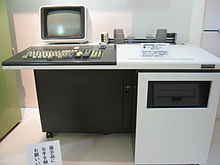History
Toshiba JW-10, the first word processor for the Japanese language (1971-1978 IEEE milestones)
Examples of standalone word processor typefaces c. 1980-1981
IBM defined the term in a broad and vague way as "the combination of people, procedures, and equipment which transforms ideas into printed communications," and originally used it to include dictating machines and ordinary, manually-operated Selectric typewriters.[6] By the early seventies, however, the term was generally understood to mean semiautomated typewriters affording at least some form of electronic editing and correction, and the ability to produce perfect "originals." Thus, the Times headlined a 1974 Xerox product as a "speedier electronic typewriter", but went on to describe the product, which had no screen,[7] as "a word processor rather than strictly a typewriter, in that it stores copy on magnetic tape or magnetic cards for retyping, corrections, and subsequent printout."[8]
Electromechanical paper-tape-based equipment such as the Friden Flexowriter had long been available; the Flexowriter allowed for operations such as repetitive typing of form letters (with a pause for the operator to manually type in the variable information),[9] and when equipped with an auxiliary reader, could perform an early version of "mail merge". Circa 1970 it began to be feasible to apply electronic computers to office automation tasks. IBM's Mag Tape Selectric Typewriter (MTST) and later Mag Card Selectric (MCST) were early devices of this kind, which allowed editing, simple revision, and repetitive typing, with a one-line display for editing single lines.[10]
The New York Times, reporting on a 1971 business equipment trade show, said
- The "buzz word" for this year's show was "word processing," or the use of electronic equipment, such as typewriters; procedures and trained personnel to maximize office efficiency. At the IBM exhibition a girl typed on an electronic typewriter. The copy was received on a magnetic tape cassette which accepted corrections, deletions, and additions and then produced a perfect letter for the boss's signature....[4]
The 1970s word processing concept did not refer merely to equipment, but, explicitly, to the use of equipment for "breaking down secretarial labor into distinct components, with some staff members handling typing exclusively while others supply administrative support. A typical operation would leave most executives without private secretaries. Instead one secretary would perform various administrative tasks for three or more secretaries."[11] A 1971 article said that "Some [secretaries] see W/P as a career ladder into management; others see it as a dead-end into the automated ghetto; others predict it will lead straight to the picket line." The National Secretaries Association, which defined secretaries as people who "can assume responsibility without direct supervision," feared that W/P would transform secretaries into "space-age typing pools." The article considered only the organizational changes resulting from secretaries operating word processors rather than typewriters; the possibility that word processors might result in managers creating documents without the intervention of secretaries was not considered—not surprising in an era when few but secretaries possessed keyboarding skills.[5]


No comments:
Post a Comment